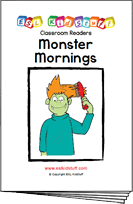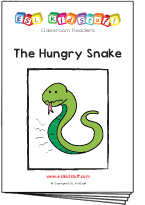Morning routines lesson plan
Stand-alone lesson ESL kids lesson plan
Lesson plans for ESL kids teachers
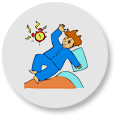
Morning routines
In this lesson students practice using the present simple tense to talk about morning routines. Students practice describing what they do each morning, play fun games and activities, sing a song and do a writing practice worksheet.
Members get accompanying flashcards, worksheets, song and classroom reader.
Download materials:
Our lesson plans are FREE!
Sign up for accompanying:
✔ worksheets
✔ homework sheets
✔ craft sheets
✔ flashcards
✔ song downloads & videos
✔ classroom readers & videos
Click to see lesson details, materials and supplies
Time: 40 mins – 1 hour
Objectives: Saying morning routine verbs.
Structures: “It’s time to …”, “I have to …”
Target vocabulary: Good morning, wake up, get up, wash my face, brush my hair, get dressed, eat breakfast, brush my teeth, put on my shoes, go to school.
Lesson materials
Flashcards:
- wake up, get up, wash my face, brush my hair, get dressed, eat breakfast, brush my teeth, put on my shoes, go to school.
Printables:
- My morning 1 worksheet
- My morning 2 worksheet
- Reader worksheet
- “The morning routines song” song poster
Songs:
- The morning routines song
Readers:
- Monster mornings
Additional materials:
- Morning routines vocab crossword
- Morning routines vocab word search
Supplies:
- [hide_on_uk]colored[/hide_on_uk][hide_on_us]coloured[/hide_on_us] pencils
- large blank paper to give students
- Blu-Tack or tape
- board with marker / chalk
- device to play the song on
This lesson introduces lots of nice daily routine verbs used in the present simple tense.
Answer: the present simple tense
When talking about everyday, habitual activities we use the present simple tense. This shows that these are things we do on a regular basis.
The present simple tense for morning routines is formed as follows:
- Use the present simple form of the verb, e.g. “I eat breakfast at 7 o’ clock.”
- Use “s” or “es” for 3rd person singular form (he, she, it), e.g. “He puts on his shoes”, “She brushes her teeth”
- For negatives, use the present simple form of the verb “do” as follows: do/does + not + infinitive without to, e.g. “I don’t go to school on Saturdays”, “She doesn’t drink tea in the morning”
- For questions, use the present simple form of the verb “do” as follows: do/does + subject + infinitive without to, e.g. “Do you eat breakfast every morning?”, “Does Freddy wake up early?”
Lesson procedure:
Warm up and maintenance:
The beginning of your lesson is extremely important: this is where you set the tone of your lesson and get everyone in the right frame of mind for learning English. It is also an opportunity to check homework and review previous lessons.
Click for warm up suggestions for the start of your lessons
These activities can be done in the following order at the start of your lesson:

1. Greetings and name tags
Greet the students by name as they enter the classroom and gesture for them to sit down. Before class prepare some blank name tags (stickers or pin-on tags). Give these out and have everyone write their names and put their tags on. If you use pin-on tags, you can keep and give out every class.

2. Homework check
Check each student’s homework set in the last lesson. Ask each student some questions about their homework worksheet (e.g. “what [hide_on_uk]color[/hide_on_uk][hide_on_us]colour[/hide_on_us] is it?”), give lots of praise, and then put some kind of mark on the homework sheet (e.g. a sticker, a stamp or draw a smiley face). Finally, tell your students to put their homework back into their bags.
3. Review past lessons
Reviewing past lessons is very important – students need constant practice of new vocab, structures, songs, games and so on. Always review parts of your last lesson as well as some parts from other previous lessons. You can spend 5-10 minutes reviewing – it’s fine to recycle games and activities from your past lessons to review as kids enjoy playing familiar games (although be careful not to play a game to death!). See the section “Other ideas to include in your warm” below for ideas.
You can also include review activities in the main body of your lesson. Kids can have short attention spans so it’s good to be able to pull out lots of activities during different stages of the lesson.
Other ideas to include in your warm up:
Ball pass questions
This is good to review questions from previous lessons. Get everybody standing in a circle.
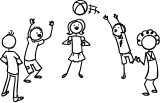
Round 1:
Take a ball and hold it and say, “My name is (you name)”. Then throw the ball to one student and say, “What’s your name?”. Students throw the ball around randomly, saying their names and asking for names.
Round 2:
This time ask a review question, e.g. “How many tables are there?”. Then throw the ball to a student who should answer, “There are (6) tables”. Help if necessary. Then that student throws the ball to another student and asks a “How many …?” question. Continue so everyone has a go. You can have multiple rounds with different topic questions.

Play “Spin the bottle”
Sit students in a circle with a bottle in the middle. Teacher spins the bottle. When it stops spinning the student it is pointing to has to answer a question. If the answer is correct then that student can spin the bottle. This is a good class warm up activity (e.g. How are you? What’s your [hide_on_uk]favorite[/hide_on_uk][hide_on_us]favourite[/hide_on_us] food? How’s the weather today?, etc.
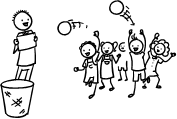
Play “Vocabulary basketball”
This is a fun game which reviews vocabulary from previous lessons. You will need a basket (a trash can) and 2 balls (or 2 pieces of A4 paper scrunched up into balls).
Form 2 teams and line them up so that two players from each team are facing the front with the basket in front of them. Let both players throw their ball – if they get their ball into the basket they can try and win a point by giving the correct answer to a question the teacher asks. This can be an actual question (e.g. What are you wearing?) or a flashcard (What’s this?). Then they go to the back of the line. At the end, the team with the most points is the winner!
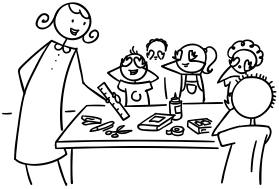
Play “What’s missing?”
This is a fun review memory game – students will have to try to remember review objects from previous lessons (e.g. classroom stationery). Lay the objects out on a table for all to see. Allow the students a minute to memorize the positions of the objects. Remove an object and hold it behind your back. Say, “Open your eyes!” – the first student who can shout out the missing object wins a point for his/her team. Play for all the objects.
Finally, calculate which team has won the most points and give them a round of applause.

Play “Quiz game show”
This is a fun quiz game, like a simple version of a TV game show. Draw some circles on the board and randomly write numbers 1, 2 or 3 in each circle. These will be points.
Put students into teams. Then ask the first team to choose a number – 1 is an easy question (e.g. “Do you like bananas?”) and 3 is a difficult question (e.g. point at a clock and ask, “What time is it?”). 2 will be in between in terms of difficulty. When the question has been answered correctly, erase that number circle. Play until all the number circles are gone – the team with the most points is the winner!
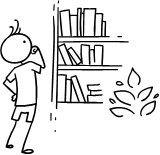
Read a classroom reader again
As you progress through the lessons you will start to build up a catalog of classroom readers (see our Readers download page at https://www.eslkidstuff.com). Kids love going back to old stories and reading through them again. Invite a student to pick a classroom reader and read through it as a class. Make the story as interactive as possible by asking questions (e.g. what [hide_on_uk]colors[/hide_on_uk][hide_on_us]colours[/hide_on_us] there are, the names of different objects, etc.) and getting students to speculate what is going to happen next in the story.

Talk about the weather (do after you have taught the weather lesson plan).
- Prepare a weather board. Before the first class prepare a piece of cardboard and cover it with felt – you are going to pin this to the wall. If you can, try and get blue felt (to represent the sky). Write at the top in large letters, “How’s the weather today?”. Below that write “Today it’s”. Cut out weather pictures (such as our weather flashcards) and stick some velcro on the back. Arrange the weather pictures around the edge of the board and then put the board on the wall of your classroom. You can now use this weather board at the beginning of every lesson.
- Ask about the weather. Ask, “How’s the weather today?” and have students put up their hands. Allow one weather condition per student (e.g. “It’s rainy”) and have each student come up and put a weather picture on the weather board.
- Introduce more weather vocabulary. Depending on weather conditions, you can introduce more weather words (with pictures … you can get students to draw them), such as:
- stormy
- misty
- showery
- freezing
- humid
- frosty
- icy
- drizzly
New learning and practice:
1. Teach the morning routines verbs
Start with a guessing game. Before class print out the flashcards for morning routines. Start with an easy one – “brush my teeth” – look at the card but don’t show it to anyone. Do the action for brushing your teeth and ask “What am I doing?”. It’s ok if the students answer in their first language – whoever answers first is the winner. Try and elicit the English or if not, teach “brush my teeth”. For the next card, the winner can look at the card and do the action. Again, elicit / teach the English. Continue until all the cards / actions have been guessed.
2. Practice the morning routines verbs
Put the cards randomly on the board (stick on with blue-tak or tape) and draw a circle around each card. Start by chorusing each card quickly (T: “wake up”, : “Wake up”). Go through chorusing all the cards at least three times, getting quicker and quicker as you go. Next, point to a card and say “What’s this?”. Get everyone to say the card together. Point to each card and get the class to shout out the verbs together as you touch each card. Finally, remove one card from the board – the circle it was in will still be there. Point to the empty circle and again say “What’s this?” – get everyone to shout out together the missing card. Point to other cards and elicit them, slowly removing all the cards from the board leaving just their circles. See if everyone can remember the words without any cards being there!
3. Play “Flashcard touch” on the board
Put the cards back on the board, at a height that everyone can reach. Model the game first – select a student and say “Touch put on my shoes”. The student should go to the board and touch the correct card. Then get the student to do the same for you. When everyone has got the idea put them in pairs and get each pair to stand at the other end of the room. In pairs, each student says a verb phrase as their partner runs to the board and touches the right card.
4. Do “Morning routines” drawings
Give out a large sheet of paper (e.g. A3) to each student and model the activity. Draw things you do in the morning (e.g. brush your teeth, eat toast, watch TV) – it doesn’t have to be just the activities from the flashcards / song, anything that you do is good. Then encourage each student to draw what they do. As they are drawing, go around the class asking questions (e.g. What’s this? Do you really eat chocolate for breakfast?, etc.). At the end, get everyone to stick their sheet of paper on the classroom walls. Pair up students and get them to try and guess what the pictures are.
5. Sing the “The morning routines song”
Put the morning routine flashcards up on the board in the order of the song, or alternatively, use our song poster. Get everyone to stand up and teach the actions and gestures for the song (see the gestures to use with the song below). Then play the song and get everyone to sing and do the actions along with you. Play twice so everyone gets the hang of it.
Lyrics for “The morning routines song”
Chorus:
Good morning! Good morning!
It’s time to wake up.
Good morning! Good morning!
I have to get up.
Verse 1:
I wash my face (wash, wash, wash),
I brush my hair (brush, brush, brush),
I get dressed (dressed, dressed, dressed),
There’s such a lot to do!
Chorus:
Good morning! Good morning!
It’s time to wake up.
Good morning! Good morning!
I have to get up.
Verse 2:
I eat my breakfast (eat, eat, eat),
I brush my teeth (brush, brush, brush),
I put on my shoes (put on, put on),
There’s such a lot to do!
It’s time to go to school.
Gestures for “The morning routines song”
As you sing the song, follow these actions:
- “Good morning! Good morning!” – stretch your arms up (as if just waking up)
- “It’s time to wake up” – point at imaginary wrist watch for “It’s time to” and open your hands in front of your eyes for “wake up” (to gesture opening your eyes)
- “I have to get up” – do an energetic star jump on “get up”.
- “I wash my face (wash, wash, wash)” – gesture washing your face
- “I brush my hair (brush, brush, brush)” – gesture brushing your hair
- “I get dressed (dressed, dressed, dressed)” – gesture getting dressed
- “There’s such a lot to do!” – gesture wiping your forehead and looking tired out
- “I eat my breakfast (eat, eat, eat)” – gesture eating breakfast
- “I brush my teeth (brush, brush, brush)” – gesture brushing your teeth
- “I put on my shoes (put on, put on)” – gesture putting on your shoes
- “It’s time to go to school.” – point at imaginary wrist watch for “It’s time to” and wave goodbye for “go to school”.
FREE SAMPLE (full-length song):
[hide_on_uk][/hide_on_uk]
[hide_on_us][/hide_on_us]
7. Read classroom reader “Monster mornings”
This reader follows on perfectly from the song and helps to reinforce the new vocab with a fun story. Before class, download and print off the reader “Monster mornings”. As you go through each page, point to the different actions that each monster is doing and elicit what they are, for example:
Teacher: (point at page 2) What color is this monster?
Students: Blue!
Teacher: Yes, that’s right. What a funny color! And what does he do every morning?
Students: Wash face!
Teacher: Yes, well done! (reading from page 2) “I wash my face”. Do you wash your face every morning (directing question to a student)?
Student: Yes!
etc.
Continue through the story, eliciting the key vocab. Get the students really involved in the story by asking lots of questions (e.g. about the colors on the monsters, asking yes/no questions, counting arms and legs, etc.).
After reading the story, give out a reader worksheet to each student and read through the story one more time (without stopping for questions, etc.) as students match the monsters to their morning activities on their sheets. Then go through the answers as a class.
Alternatively, watch our video version of the reader (Internet connection required).
7. Do the “My morning 1” worksheet
Give out the My morning 1 worksheet to each student. Model the worksheet and then have everyone work on the sentences. As everyone is working on their worksheets go around the class and ask questions (e.g. What does that say? Do you take a shower in the morning?).
8. Play charades
To finish the class, get together the morning routines flashcards and also any other action verb flashcards you have used in previous lessons. Divide the class into 2 teams. One student comes to the front of the class and acts out the flashcard you show to him/her. The first person to shout out the correct answer wins a point for his/her team.
Wrap up:
Assign homework: “My morning 2” worksheet
Click for wrap up suggestions for the end of your lessons

1. Assign homework
Each week give out a homework worksheet for your students to take home. Hold up the homework worksheet and model how to do it. Give out the worksheets and say, “Put your homework in your bags”.

2. Do “Quick check”
Time to leave the class. Make sure everything is put away and the students have gathered their belongings. Have them line up at the door and place yourself between the door and the students. For each student check one new word or phrase, for example:
- hold up an object or flashcard (such as an item of clothing) and ask, “What’s this?”
- ask a question from the lesson (e.g. “Where do you live?”, “Do you like bananas?”, “Can you play chess?”, etc.)
When they give you the correct answer say goodbye and let them leave. If their answer is wrong, have them go back to the end of the line – they will have to try again once they reach the front!
Other lesson plans
Actions, verbs & tenses:
- Can – for ability
- Morning routines
- Daily routines & times of the day
- Actions – Present continuous
- Future plans using “going to”
- Past tense activities – Regular verbs
- Past tense activities – Irregular verbs: Part 1
- Past tense activities – Irregular verbs: Part 2
Adjectives:
- Describing people
- Describing things
- Comparing things (Comparative adjectives)
- Comparing things (Superlative adjectives)
Adverbs:
Alphabet:
Animals:
Body:
Classroom:
Clothes:
Colors:
Colours:
Directions:
Family:
Feelings & emotions:
Food:
Health & sickness:
Holidays & festivals:
Jobs:
Likes, dislikes & favorites:
Likes, dislikes & favourites:
- Likes & dislikes
- [hide_on_uk]Favorites[/hide_on_uk][hide_on_us]Favourites[/hide_on_us] and asking why
Nature & Our world:
Numbers:
Places & where we live:
Prepositions of location:
Pronouns:
Shapes:
Shopping:
Sports:
Time, days, months, seasons:
Toys:
Transport & travel:
Weather:


